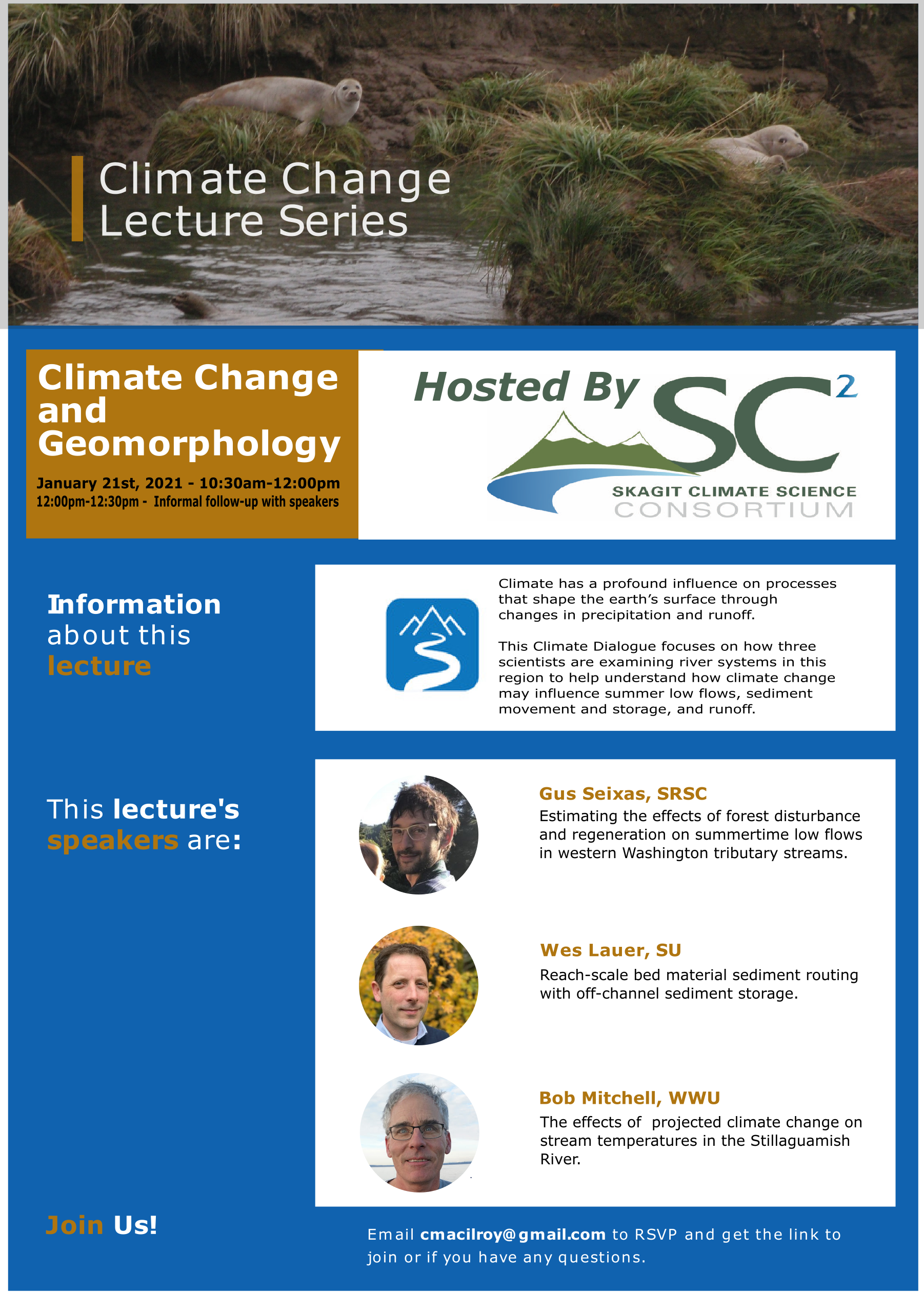Dialogue on Climate Change and Geomorphology — January 21st from 10:30–12:00
Climate has a profound influence on processes that shape the earth’s surface through changes in precipitation and runoff. This Climate Dialogue focuses on three scientists who are examining river systems in this region to help understand how climate change may influence summer low flows, sediment movement and storage, and runoff.
Speakers include:
- Gus Seixas’s (Skagit River System Cooperative): Estimating the effects of forest disturbance and regeneration on summertime low flows in western Washington tributary streams
-
- PDF of Presentation Powerpoint: Gus Seixas’s Presentation
- Talk Overview: It has long been recognized that flow volumes in forested watersheds may be elevated within the first decade or two after timber harvest due to reduced evapotranspiration. More recently, researchers have demonstrated that intermediate-aged Douglas-fir stands (10–50+ years) may reduce summertime flow volumes by as much as 50% in experimental basins of uniform age in the Oregon Cascades. Understanding the potential balance between flow increases following timber harvest and flow deficits as forests regenerate is critical for aquatic and water resource conservation and management, especially in the face of predicted reductions in baseflow due to climate change. In this talk, I will present new research aimed at estimating the effects of forestry on summertime base flow in Skagit River tributary streams, including a novel method of predicting forest stand age structure at the watershed scale.
- Dr. Wes Lauer (Seattle University): Reach-scale bed material sediment routing with off-channel sediment storage
-
- PDF of Presentation Powerpoint: Dr. Wes Lauer’s Presentation
- Talk Overview: Rivers can adjust their capacity in response to changes in sediment supply or driving hydrologic conditions, but these adjustments are moderated by movement of sediment into and out of floodplains. These processes have been represented in a simple way using the model Morphodynamics and Sediment Tracers in 1‑D (MAST-1D). Many of the datasets necessary for application of a model like MAST-1D to the Skagit system are available, but work would be required to represent the main channels in the network and to adequately characterize tributary sediment supply.
- Dr. Bob Mitchell (Western Washington University): The effects of projected climate change on stream temperatures in the Stillaguamish River
-
- PDF of Presentation Powerpoint: Dr. Bob Mitchell’s Presentation
- Talk Overview: For the past 10 years Bob has been collaborating with the Nooksack Indian Tribe and the Stillaguamish Tribe of Indians. This work involves modeling the effects of projected climate change on snowpack, glacier recession, streamflow, and stream temperatures in the Nooksack and Stillaguamish River basins to inform salmon habitat management and restoration.

Detailed Bios and Referenced Speaker Publications:
Gus Seixas:
Gus Seixas is the Watershed Scientist with the Forests and Fish Program at the Skagit River System Cooperative (SRSC). He began his career studying the relationship between uplift of the Earth’s crust during mountain building and landscape evolution, eventually completing a Master of Science degree at Stanford University in 2015. After graduate school, Gus turned his attention to river restoration and protection, first as a contract employee with the NOAA Fisheries Watershed Program and then in his current position at SRSC. His current work focuses on fish habitat protection in timber lands both through participation in timber management regulation and research on geomorphic processes in small headwater streams, the effects of land management on stream temperature patterns and the legacy of forestry in creating summertime low flow deficits, among other topics.
https://nwifc.org/publications/state-of-our-watersheds/
Dr. Wes Lauer:
Dr. Wes Lauer works as a professor in the civil and environmental engineering and environmental science programs at Seattle University. His educational background includes degrees from the University of Minnesota (Ph.D., 2006), U.C. Berkeley (M.Eng., 1998), and Walla Walla University (B.S.E. in Civil Engineering, 1996). Research interests focus on the measurement and simulation of decadal-scale changes in channel and floodplain morphology along alluvial rivers. The work has applications in flood management, geomorphic assessment of riparian habitat quality, and numerical modeling of hydraulic, hydrologic, and geomorphic processes. He has also worked professionally as a consulting civil engineer and hydrologist.
De Rego, K., Eaton, B., Lauer, J.W., Hassan, M., (2020), A decadal-scale numerical model for wandering, cobble-bedded rivers subject to disturbance. Earth Surface Processes and Landforms. DOI: 10.1002/esp.4784
Research Gate Link: Click Here
Lauer, J.W., C. Echterling, C. Lenhart, P. Belmont, R. Rausch, (2017). Air-photo based change in channel width in the Minnesota River basin: Modes of adjustment and implications for sediment budget. Geomorphology 297, 170–184. DOI: 10.1016/j.geomorph.2017.09.005
Research Gate Link: Click Here
Lauer, J.W., E. Viparelli, H. Piégay, (2016). Morphodynamics and Sediment Tracers in 1‑D (MAST-1D): 1‑D sediment transport that includes exchange with an off-channel sediment reservoir. Advances in Water Resources 98: 135–149. DOI: 10.1016/j.advwatres.2016.01.012
Research Gate Link: Click Here
Email: lauerj@seattleu.edu for a copy if interested.
Dr. Bob Mitchell:
Dr. Robert (Bob) Mitchell currently serves as the Digges Distinguished Professor of Engineering Geology in the Geology Department at Western Washington University where he has been a faculty member since 1996. He has degrees in geology (BS), geophysics (MS), physics (MS), and a Ph.D. in Environmental Engineering. Bob teaches courses in engineering geology, surface-water hydrology, hydrogeology, ground-water contamination, and GIS. His actionable-science research interests include modeling the effects of climate change on mountain hydrology and hillslope processes including snowpack, glacier recession, streamflow, stream temperatures, and stream sediment; quantifying the effects of agricultural practices on groundwater quality; and aquifer characterization. His research efforts have supported numerous MS graduate students and have been instrumental to management and policy decisions regarding water quantity and quality for regional tribes, regulatory agencies, and municipalities. Bob has held leadership positions in state and national professional organizations and currently serves as chair on the Board of the Environmental & Engineering Division of the Geological Society of America.
Email Dr. Mitchell if you want a copy of the paper below.
Dickerson‐Lange, S.E. and Mitchell, R., 2014. Modeling the effects of climate change projections on streamflow in the Nooksack River basin, Northwest Washington. Hydrological Processes, 28(20):5236–5250
